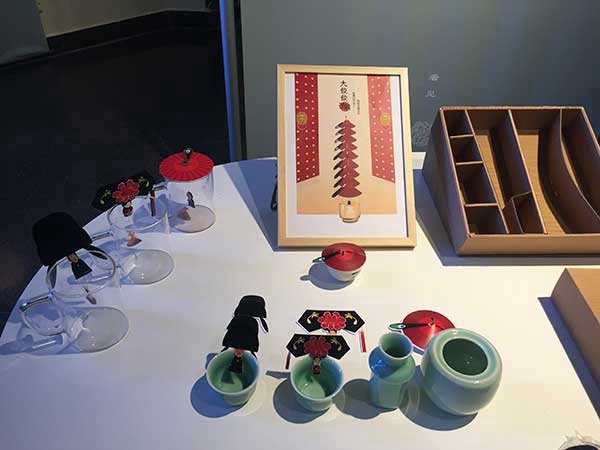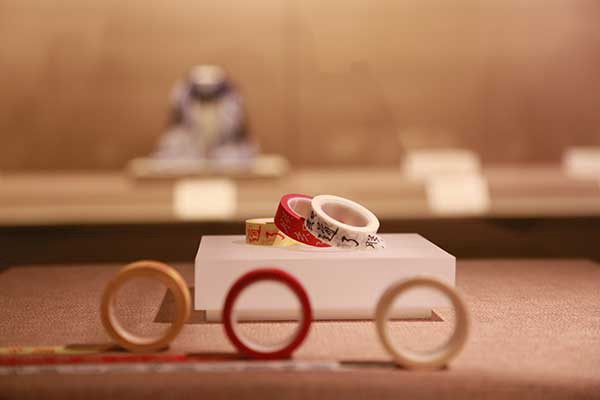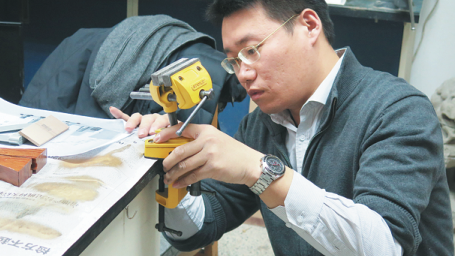
Young designers find creative ways to make China's ancient heritage both relevant and beautiful. Lin Qi reports.
It has been a rather busy time for graduates like Zhen Min, 28, who will soon receive her master's degree at Peking University's school of arts. While she prepares for her thesis defense and further studies abroad, she also makes time to finalize a design with her partner in Shanghai.
Zhen is majoring in art management and creative industry, and is especially interested in how to relate cultural heritage to modern life. She is a member of a designer duo, teaming up with Jia Min, a student of design at East China Normal University. The young women met on a train and found they were both from the Inner Mongolia autonomous region.
Now they are racking their brains to design a group of figurines to be used as tea-bag holders. The hat of each human figure, who wears a different Peking Opera costume and makeup, must be able to cling to the lip of a teacup. The figure's body will be a place to hang the attached string of a tea bag.

The two were approached by the client, a Beijing theater, after their first works were shown at a Peking University exhibition in January.
There, three silica-gel holders were crafted to resemble headwear of an official and a princess of the Qing Dynasty (1644-1911) and a bureaucrat of the 10th-century Southern Tang Dynasty.
The theater's staff liked the holders and asked Zhen and Jia whether they could design a series of Peking Opera figures.
The designs were among some 35 works on show that won prizes at a design competition organized by Peking University's department of archaeology and museology.
The competition and exhibition is part of the department's ongoing Yuanliu Campaign, an initiative that seeks cross-disciplinary approaches to fostering art, history and design.
The competition attracted more than 300 submissions from college students across the country, including Hong Kong, Macao and Taiwan.
The students study fine art, archaeology, industrial design, history, computer and material science. And their works include designs for furniture, stationery, animations and apps.

Blending art into life
Zhen says she was on an exchange program at a Taipei university when submissions opened in October 2015.
Her major inspirations were popular, inexpensive souvenirs sold at the Taipei Palace Museum shops.
"From the very beginning, we wanted to design something that could be manufactured and sold," says Zhen.
"So, it had to be simple and useful so that people would buy it. And it had to be low-cost, priced at no more than 20 yuan ($3)."
For the cultural message, Zhen says popular Chinese TV dramas that showcase Qing's court life provided them with ideas.
She says not only did she realize that big official hats could be the model for a lid but, after she flipped through historical books, she found that some characters didn't wear the correct hats that matched their ranks.
"We could design something that people needed on a daily basis while telling them what people in the imperial court wore on their heads," adds Zhen.

The work exemplifies the motto of the Yuanliu Campaign: People better appreciate the lingering charm of history and culture when they actually live with the heritage.
Hang Kan, professor and director of Peking University's department of archaeology and museology, says, "Yuan means tracing Chinese cultural roots and liu means looking at the present and to the future."
He says Peking University's department of archaeology and museology took up the campaign two years ago because it felt that archaeologists were guarding "an immense treasure trove of knowledge", but for a long time, they were not able to make use of it.
He says archaeological activities provide abundant information that is cross-disciplinary and therefore, it relies on the expertise of both archaeologists and people working in many other fields.
"For example, we once discovered crop seeds at a digging site, and we needed to work with agriculturists to decipher messages they carried-how the farming was conducted in ancient times and whether it is still relevant today."
He says archaeological discoveries should not be exclusive to professionals and scholars-they should also be conveyed to the general public and integrated into their daily life.

Crossover cooperation
The blue logo of the Yuanliu Campaign is his department's first effort to show that cultural heritage is visually appealing while embedded with secrets of a civilization. Designed by Jia, it resembles a pottery owl head belonging to the Neolithic Yangshao Culture.
The round object was excavated by the department's students in Hua county, in northwestern Shaanxi province, in the 1950s.
But researchers still aren't sure what it was used for.
Meanwhile, the campaign has brought together a team of teachers and students from various academic departments. They operate a WeChat account to post articles, introduce antique works of art and comment on ongoing exhibitions. The followers include students, journalists, designers and researchers.
Hang says the cross-disciplinary mindset is widely practiced at Peking University, because it is believed to broaden a graduate's career prospects.
The campaign's second design competition is to be launched in the second half of the year.

Wang Jiayue, a teacher at the department who heads the Yuanliu Campaign team, says many winning designs from the first competition were not perfect, and many couldn't be turned into products because of design faults.
But she applauds the students' creativity, noting that such work is a long-term commitment.
Hang says the campaign organizers also plan to collaborate with artists, designers and craftsmen to stage a series of exhibitions.
"Museums also reach out to us. They feel that the competition will provide good ideas and designs that can someday be turned into souvenirs for their shops."
Zeng Shijing, another winner at the first competition, says the Yuanliu Campaign enabled her to see many good designs, each a creative solution to blend traditional culture into daily life.
She designed an app that combines a weather forecast with beautiful female costumes of the Tang Dynasty (618-907). It was also her project for her master's degree at the Tsinghua University's art and design department.
Speaking about the campaign, Zeng says: "I believe new technologies and equipment will provide more possibilities of integrating cultural heritage into our lives. And designers should play a bigger role because excellent designs will influence more people."



